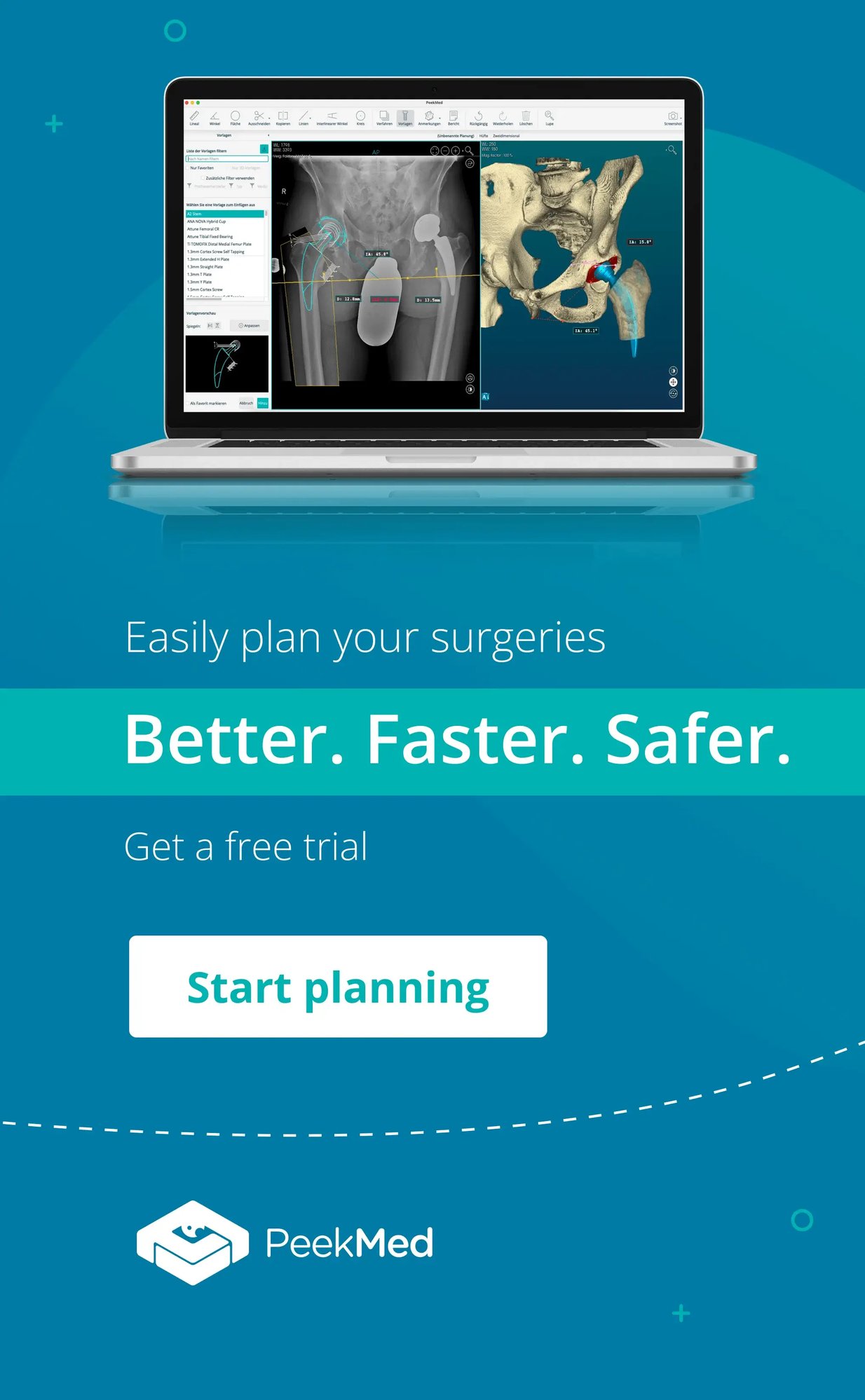PeekMed
Imagine walking into an operating room with complete confidence, knowing that every detail of your patient’s procedure has been meticulously planned. This is the power of digital templating—a critical step in preoperative planning that enhances surgical precision and improves patient outcomes.
In this article, we will explore the key aspects of digital templating in orthopedic surgery, from its basic principles to its practical applications. You'll gain insight into the process, the technology behind it, and how it is changing surgical practice. Whether you're a surgeon, radiologist, or allied health professional, understanding the impact of digital templating can improve accuracy and patient outcomes. Read on to dive into the details and explore how advances in templating software can improve your workflow and outcomes.
Table of Contents:
Digital Templating Orthopedic Surgery
The Benefits of Digital Templating
Digital Templating Solutions: the PeekMed case
Best Practices for Effective Digital Templating
The Future of Orthopedic Surgery
Digital Templating in Orthopedic Surgery
Digital templating in orthopedic surgery involves selecting and positioning the appropriate implant size and type before surgery. Traditionally, surgeons used acetate overlays on printed X-rays to estimate implant size and alignment. However, this manual process often led to inaccuracies, increasing the likelihood of complications during surgery.
The shift to digital templating has transformed this process. By leveraging software solutions like PeekMed, surgeons can now use patient-specific anatomical data to create precise preoperative plans. But how does this improve surgical outcomes? Let’s explore.
The Benefits of Digital Templating
Digital templating offers significant advantages over traditional methods, including:
Increased Accuracy in Implant Sizing
Choosing the right implant size is crucial. An undersized or oversized implant can lead to complications, such as implant loosening or joint instability. Digital templating software enables surgeons to make precise measurements using high-resolution imaging and automated tools, significantly reducing the margin for error.
Reduced Intraoperative Surprises
Nobody likes surprises in the operating room. Digital templating allows surgeons to anticipate and mitigate potential challenges before making the first incision. This means fewer unexpected complications, shorter operating times, and improved patient safety.
Enhanced Efficiency and Cost Savings
Time is money in the healthcare industry. By streamlining the preoperative planning process, digital templating reduces the time spent on manual calculations and adjustments. This leads to more efficient surgeries and lower hospital costs associated with implant wastage and extended operative times.
Digital Templating Solution: the PeekMed case
Here’s the deal: not all digital templating solutions are created equal. PeekMed stands out as a cutting-edge platform designed to optimize orthopedic surgical planning. Here are some key features and advantages:
-
Advanced 3D Planning: PeekMed allows surgeons to plan in both 2D and 3D, providing a comprehensive visualization of the surgical site.
-
Seamless Workflow Integration: Designed to work with existing hospital PACS (Picture Archiving and Communication System), ensuring smooth implementation.
-
AI-Powered Automation: Automates implant selection and positioning, reducing human error and improving accuracy.
-
Cloud-Based Accessibility: Enables surgeons to access digital templating data from anywhere, facilitating collaboration between surgical teams.
Best Practices for Effective Digital Templating
Want to get the most out of digital templating? Here are some expert tips:
1. Ensure High-Quality Imaging
Garbage in, garbage out. The accuracy of digital templating relies on high-resolution, properly calibrated X-rays or CT scans. Always ensure that imaging is taken under standardized conditions.
2. Stay Updated with Training
Technology is constantly evolving. Regular training on new software features and best practices ensures that surgeons and radiologists can fully leverage digital templating tools.
3. Collaborate with the Surgical Team
A well-executed surgical plan requires seamless communication. Engaging the entire surgical team in the digital templating process ensures that everyone is aligned with the preoperative strategy.
4. Double-Check Your Plan
Even with AI-powered automation, human oversight remains essential. Always review digital templating results before finalizing your surgical approach.
The Future of Orthopedic Surgery
Digital templating has come a long way from manual acetate overlays to AI-driven solutions. With continuous advancements in technology, and software like Peekmed, the future of orthopedic surgery is set to become even more precise, efficient, and patient-centered.
As digital templating continues to evolve, we can expect even greater integration with artificial intelligence, improved automation, and enhanced collaboration between surgical teams worldwide. The goal remains the same: to provide safer, more effective, and more predictable patient outcomes.
References
Materialise. (2021). 10 considerations for orthopedic templating software, PACS & tender. Materialise. Retrieved from https://www.materialise.com/en/inspiration/articles/10-considerations-orthopaedic-templating-software-pacs-tender
ScienceDirect. (2022). A study on orthopedic templating. Journal of Orthopedic Research, 40(6), 1502-1509. Retrieved from https://www.sciencedirect.com/science/article/pii/S002013832200660X
ScienceDirect. (2024). Orthopedic templating software in modern practice. Computer Methods in Biomechanics and Biomedical Engineering, 27(1), 1-8. Retrieved from https://www.sciencedirect.com/science/article/pii/S0968016024000061



